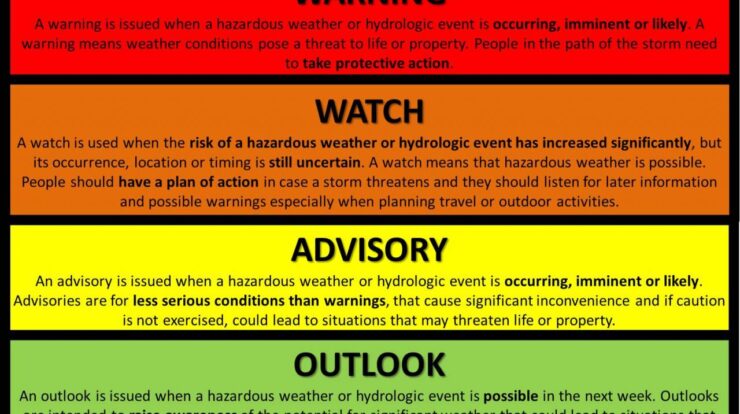
Is a watch or warning worse? When it comes to weather alerts, understanding the difference between these two terms is crucial. This guide will delve into the severity of watches and warnings, exploring the factors that determine their issuance and their impact on individuals and communities.
The severity of weather alerts varies depending on the level of threat they pose. Watches indicate the possibility of severe weather developing within a certain timeframe, while warnings signal that severe weather is imminent or already occurring.
Severity of Warnings vs. Watches
A watch is issued when conditions are favorable for the development of severe weather, while a warning is issued when severe weather is imminent or already occurring. Watches are less severe than warnings and provide more lead time, while warnings indicate that immediate action is required to protect life and property.
Criteria for Issuing Watches and Warnings
The National Weather Service (NWS) uses specific criteria to issue watches and warnings. A watch is issued when there is a potential for severe weather within the next 48 hours, while a warning is issued when severe weather is expected within the next 60 minutes.
Factors to Consider
When determining whether to issue a watch or warning, the NWS considers several factors, including:
- Radar data
- Satellite imagery
- Weather station reports
- Forecast models
- Local conditions
When to Issue a Watch, Is a watch or warning worse
A watch is typically issued when there is a potential for severe weather, but the exact location and timing of the event is uncertain. This provides people with time to prepare and take precautions, such as securing loose objects and making sure they have a plan in place in case of severe weather.
When to Issue a Warning
A warning is issued when severe weather is imminent or already occurring. This means that people need to take immediate action to protect themselves and their property. Warnings are typically issued for specific areas and provide information about the type of severe weather expected, such as tornadoes, hail, or flooding.
Impact on Individuals and Communities: Is A Watch Or Warning Worse

Watches and warnings can have a significant impact on individuals and communities. Watches can provide peace of mind and allow people to prepare for severe weather, while warnings can save lives and property.
Navigating the nuanced difference between watch and warning is crucial, especially when planning outdoor adventures. Knowing when to heed a watch or warning can make all the difference between an enjoyable experience and a potentially dangerous situation. On a lighter note, if you’re an avid combat sports enthusiast, you won’t want to miss the thrill of bare knuckle fighting . It’s a raw and adrenaline-pumping spectacle that’s sure to leave you on the edge of your seat.
It is important to understand the difference between watches and warnings and to take appropriate action when they are issued. Ignoring a warning can put you and your loved ones at risk.
Communication and Education
Effective communication and education are essential to ensuring that the public understands the difference between watches and warnings. The NWS uses a variety of channels to communicate weather information, including:
- Weather forecasts
- Social media
- Mobile apps
- Emergency alerts
The NWS also works with schools and community groups to provide educational programs about severe weather safety. By understanding the difference between watches and warnings, and by taking appropriate action when they are issued, you can help keep yourself and your loved ones safe.
Last Point
Understanding the difference between watches and warnings is essential for public safety. By recognizing the severity of each alert, individuals can take appropriate actions to protect themselves and their communities. Effective communication and education play a vital role in ensuring that the public comprehends the significance of these alerts and responds accordingly.
Common Queries
What is the difference between a watch and a warning?
A watch indicates the possibility of severe weather developing within a certain timeframe, while a warning signals that severe weather is imminent or already occurring.
What factors determine whether a watch or warning is issued?
For those seeking entertainment, ION offers a diverse selection of programming, catering to various tastes. Whether you prefer classic movies, captivating documentaries, or engaging news coverage, ION has something for everyone. And if you’re an Apple enthusiast, don’t miss out on the latest must-see shows and movies available on Apple TV .
The severity of the weather threat, the likelihood of it occurring, and the lead time available to issue the alert.
What should I do if I receive a watch or warning?
For a watch, be prepared to take action if conditions worsen. For a warning, take immediate action to protect yourself and your property.





